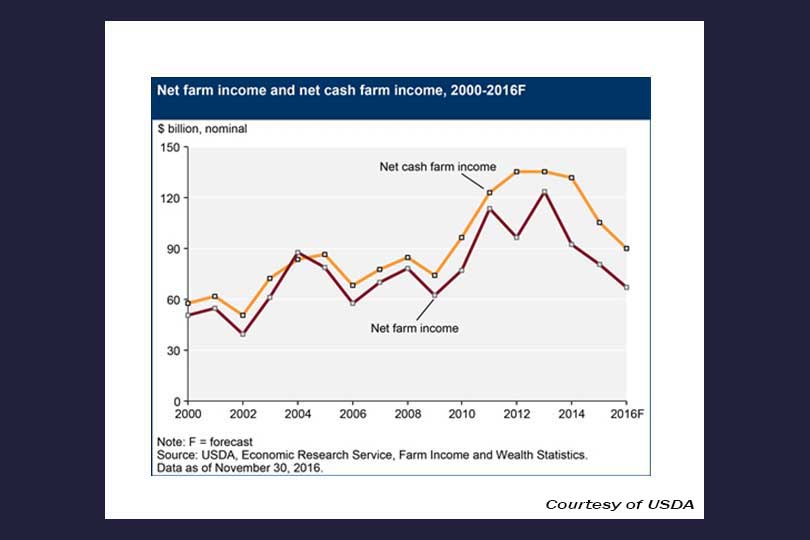The U.S. Department of Agriculture’s (USDA’s) Economic Research Service (ERS) released its final farm income forecast for 2016. The agency predicts a drop in farm income for the third consecutive year.
Net cash farm income is forecast at $90.1 billion, a decrease of 14.6 percent from 2015. Net farm income is forecast at $66.9 billion, a decrease of 17.2 percent from last year.
“Today’s forecast continues to show that the health of the overall farm economy is strong in the face of challenging markets,” Agriculture Secretary Tom Vilsack said in a statement. “After reaching record highs in 2012-2014, net farm income declined in 2015 and is forecast to decline in 2016, but the bigger picture shows that farm income over the last five-year period reflects the highest average five-year period on record.”
The animal ag sector could have the biggest impact on the decrease, according to Agri-Pulse.
Animal/animal product cash receipts are expected to fall $23.4 billion, or 12.3 percent, in 2016.
The report forecasts dairy, meat animals and poultry/eggs to have lower receipts. Cattle/calf receipts are forecast to fall almost 15 percent to $11.6 billion. Hog cash receipts are forecast to fall nearly 7 percent. Milk receipts are forecast to drop more than 31 percent to $15.4 billion. Poultry and egg cash receipts are expected to fall more than 18 percent due to a decline in egg receipts. Turkey cash receipts are expected to go up 10.6 percent.
The cash income from crop sales during the 2016 calendar year are forecast essentially unchanged as prices continue to decline for most field crops. Cash receipts across all commodities are expected to fall more than 6 percent to $23.4 billion in 2016.
Weakened corn prices lead corn cash receipts to fall by almost $2 billion or four percent from last year. Wheat receipts are expected to decrease almost $1 billion or 10 percent from 2015.
Increased soybean production is expected to be supplemented by higher prices in 2016. Soybean cash receipts are forecast to increase by more than $5 billion. Rice receipts are forecast to fall, while cotton receipts are expected to increase.
Farm production expenses are predicted to fall for the second consecutive year, while government payments increase, Agri-Pulse reports.
The ERS forecasts a $9.2 billion decline in production expenses from last year, a decrease of 2.6 percent. The forecast decline in production expenses is predominantly driven by less spending on livestock and poultry purchases, fertilizer and fuel.
Net rent expenses are also forecast to decline by almost $20 billion or 1.6 percent.
“The comprehensive farm safety net provided by the 2014 Farm Bill will continue to help America’s farmers and ranchers respond to market conditions and provide financial stability for producers,” Vilsack said.
Farm program payments are forecast to rise 19.1 percent to $12.9 billion. The Price Loss Coverage (PLC) and Agriculture Risk Coverage (ARC) programs are expected to account for 64.4 percent of all program payments. About 69 percent of 2016 ARC-Co payments are expected to go to farmers with corn base acres, 18.5 percent to soybean base farmers and another 10.8 percent to farmers with wheat base acres.
Total median farm household income will see a slight increase of 1 percent.
“Median household income for farming families remains near historic highs and is expected to remain stable relative to 2015,” Vilsack said. “In 2016, higher off-farm earnings are expected to help stabilize losses due to low commodity prices.”
Vilsack said rural unemployment rates have dropped below 6 percent for the first time since 2007.
“The future of rural America looks much brighter today, but we must continue to focus on the targeted investments to help the rural economy retool itself for the 21st century,” Vilsack said.

